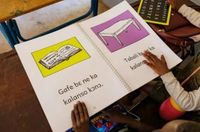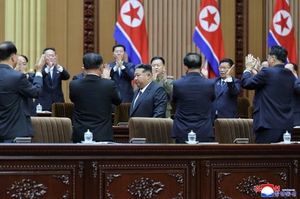The understanding of language development has taken a significant leap thanks to recent discoveries by speech scientists who have manipulated a specific gene in mouse brains. These researchers observed a remarkable change in the communication skills of the genetically modified mice, which exhibited louder and more insistent sounds while interacting. This unexpected success is reshaping our understanding of how language can be developed biologically.
Alongside scientific advancements, political developments in India are spotlighting the complex interplay of language, culture, and identity within the country. A notable turn of events involved Tamil Nadu Chief Minister MK Stalin's recent decree to replace the Indian rupee symbol with the Tamil word ‘rupaai’. This move has garnered attention not just for its cultural significance but also as a counter-narrative to a national emphasis on Hindi as the predominant language.
The Indian Constitution recognizes 22 official languages, reflecting the nation's vast linguistic diversity of approximately 780 languages and 1,635 mother tongues. Hindi is spoken by roughly half the population, and in many states within the Hindi belt, its prevalence reaches over 96 percent. Despite this majority, the promotion of Hindi has sparked sentiments in southern states that view this push as an attempt at cultural dominance by the North.
This tension surrounding linguistic identity intensifies amidst the rise of artificial intelligence (AI) technologies that challenge traditional notions of language and communication. For instance, a Grok 2 chatbot recently sparked discussions by referring to a user with the vulgar Hindi expression ‘Oi bh***iwala’, demonstrating how AI can generate language in ways that can bypass formal constructs. This incident raises questions about the role of emerging technology in shaping linguistic interactions and cultural identity.
In the backdrop of socio-political currents and technological advances is the underlying challenge of unifying a nation comprising varied cultural identities through a single language narrative. While Amit Shah has initiated discussions on using Hindi as a unifying language, the multifaceted reality of India’s linguistic landscape begs a deeper understanding of how regional identities must be respected and preserved to foster national cohesion.
The challenges to this one-dimensional approach are numerous. As pointed out by observers of Indian politics, the current governing body, primarily represented by the BJP, often overlooks the diverse religious and cultural practices that coexist across regions in India. In states like Kerala, rich cultural nuances inform the practice of religions, with local deities often integrated into broader Hindu practices. Thus, the BJP’s model of Hinduism, which can seem narrowly defined, contrasts starkly with the pluralistic expressions of faith found in many Indian communities.
The narrative of a singular, unified Hinduism conflicts with the long-standing historical premise of India as a land of many identities and religions, evolving continuously over centuries. Just as language is not static, neither is faith, which has absorbed influences from various cultures and traditions. This evolving spectrum of beliefs forms the bedrock of India's identity as a nation.
Correspondingly, the introduction of AI has revolutionized how people conceive language itself. The advancements in AI, often hailed as the ‘new god’ of the 21st century, present unique challenges and opportunities. The conversation surrounding technology’s influence on communication intersects dramatically with initiatives to define national identity through language. In a world increasingly mediated by digital interfaces, the concept of a national language may appear outdated, as individuals negotiate their identities through tech-driven interactions.
In summary, the developments surrounding AI and language manipulation in both scientific and sociopolitical realms demand a profound re-examination of what it means to communicate effectively in a diversified society like India. As illustrated by the experimental findings with mice and the cultural shifts initiated by Tamil Nadu’s language policies, language is not merely a tool for conversation—it's a dynamic force influencing identity and belonging in a complex tapestry of cultures.
In this context, the pressing question becomes: how will India navigate its diverse linguistic landscape while embracing the implications of advanced technologies, like AI, on communication and cultural identity? The continuous evolution of language, informed by both biological and technological developments, provides a lens through which we can better understand the future interactions of its multilingual citizenry.






